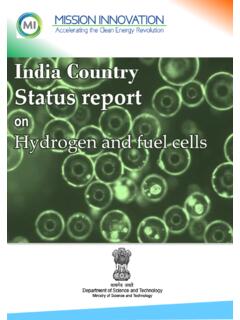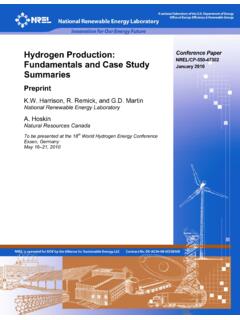Transcription of Hodgkin-Huxley Models
1 1 CHAPTER EXCERPT FROM: Nelson, (2004) Electrophysiological Models In: Databasing the Brain: From Data to Knowledge. (S. Koslow and S. Subramaniam, eds.) Wiley, New York. Hodgkin-Huxley Models The core mathematical framework for modern biophysically based neural modeling was developed half a century ago by Sir Alan Hodgkin and Sir Andrew Huxley. They carried out an elegant series of electrophysiological experiments on the squid giant axon in the late 1940s and early 1950s. The squid giant axon is notable for its extraordinarily large diameter (~ mm). Most axons in the squid nervous system and in other nervous systems are typically at least 100 times thinner. The large size of the squid giant axon is a specialization for rapid conduction of action potentials that trigger the contraction of the squid s mantle when escaping from a predator.
2 In addition to being beneficial for the squid, the large diameter of the giant axon was beneficial for Hodgkin and Huxley because it permitted manipulations that were not technically feasible in smaller axons that had been used in biophysical studies up to that point. In a well-designed series of experiments, Hodgkin and Huxley systematically demonstrated how the macroscopic ionic currents in the squid giant axon could be understood in terms of changes in Na+ and K+ conductances in the axon membrane. Based on a series of voltage-clamp experiments, they developed a detailed mathematical model of the voltage-dependent and time-dependent properties of the Na+ and K+ conductances. The empirical work lead to the development of a coupled set of differential equations describing the ionic basis of the action potential (Hodgkin and Huxley, 1952), which became known as the Hodgkin-Huxley (HH) model.
3 The real predictive power of the model became evident when Hodgkin and Huxley demonstrated that numerical integration of these differential equations (using a hand-cranked mechanical calculator!) could accurately reproduce all the key biophysical properties of the action potential. For this outstanding achievement, Hodgkin and Huxley were awarded the 1963 Nobel Prize in Physiology and Medicine (shared with Sir John Eccles for his work on the biophysical basis of synaptic transmission). Electrical equivalent circuits In biophysically based neural modeling, the electrical properties of a neuron are represented in terms of an electrical equivalent circuit. Capacitors are used to model the charge storage capacity of the cell membrane, resistors are used to model the various types of ion channels embedded in membrane, and batteries are used to represent the electrochemical potentials established by differing intra- and extracellular ion concentrations.
4 In their seminal paper on the biophysical basis of the action potential, Hodgkin and Huxley (1952) modeled a segment of squid giant axon using an equivalent circuit similar to that shown in Fig. 1. In the equivalent circuit, the current across the membrane has two major components, one associated with the membrane capacitance and one associated with the flow of ions through resistive membrane channels. The capacitive current Ic is defined by the rate of change of charge q at the membrane surface: Ic = dq/dt. The charge q(t) is related to the instantaneous membrane voltage Vm(t) and membrane capacitance Cm by the relationship q = CmVm. Thus the capacitive current can be rewritten as Ic = Cm dVm/dt. In the Hodgkin-Huxley model of the squid axon, the ionic current Iion is subdivided into three distinct components, a sodium current INa, a potassium Nelson, (2004) Electrophysiological Models In: Databasing the Brain: From Data to Knowledge.
5 (S. Koslow and S. Subramaniam, eds.) Wiley, New York. current IK, and a small leakage current IL that is primarily carried by chloride ions. The behavior of an electrical circuit of the type shown in Fig. 1 can be described by a differential equation of the general form: extionmmIIdtdVC=+ (1) where Iext is an externally applied current, such as might be introduced through an intracellular electrode. Equation 1 is the fundamental equation relating the change in membrane potential to the currents flowing across the membrane. Macroscopic Ionic Currents The individual ionic currents INa, IK and IL shown in Fig. 1 represent the macroscopic currents flowing through a large population of individual ion channels. In HH-style Models , the macroscopic current is assumed to be related to the membrane voltage through an Ohm s law relationship of the form V=IR.
6 In many cases it is more convenient to express this relationship in terms of conductance rather than resistance, in which case Ohm s law becomes I = GV, where the conductance G is the inverse of resistance, G = 1/R. In applying this relationship to ion channels, the equilibrium potential Ek for each ion type also needs to be taken into account. This is the potential at which the net ionic current flowing across the membrane would be zero. The equilibrium potentials are represented by the batteries in Fig. 1. The current is proportional to the Fig. 1 Electrical equivalent circuit for a short segment of squid giant axon. The capacitor represents the capacitance of the cell membrane; the two variable resistors represent voltage-dependent Na+ and K+conductances, the fixed resistor represents a voltage-independent leakage conductance and the three batteries represent reversal potentials for the corresponding conductances.
7 The pathway labeled stim represents an externally applied current, such as might be introduced via an intracellular electrode. The sign conventions for the various currents are indicated by the directions of the corresponding arrows. Note that the arrow for the external stimulus current Iext is directed from outside to inside ( , inward stimulus current is positive), whereas arrows for the ionic currents INa, IK and IL are directed from inside to outside ( , outward ionic currents are positive). After Hodgkin & Huxley (1952). Nelson, (2004) Electrophysiological Models In: Databasing the Brain: From Data to Knowledge. (S. Koslow and S. Subramaniam, eds.) Wiley, New York. conductance times the difference between the membrane potential Vm and the equilibrium potential Ek.
8 The total ionic current Iion is the algebraic sum of the individual contributions from all participating channel types found in the cell membrane: ==kkmkkkionEVGII)( (2) which expands to the following expression for the Hodgkin-Huxley model of the squid axon: )()()(LmLKmKNamNaionEVGEVGEVGI + + = (3) Note that individual ionic currents can be positive or negative depending on whether or not the membrane voltage is above or below the equilibrium potential. This raises the question of sign conventions. Is a positive ionic current flowing into or out of the cell? The most commonly used sign convention in neural modeling is that ionic current flowing out of the cell is positive and ionic current flowing into the cell is negative (see subsection on Sign Conventions for more details).
9 In general, the conductances are not constant values, but can depend on other factors like the membrane voltage or the intracellular calcium concentration. In order to explain their experimental data, Hodgkin and Huxley postulated that GNa and GK were voltage-dependent quantities, whereas the leakage current GL was taken to be constant. Thus the resistor symbols in Fig. 1 are shown as variable resistors for GNa and GK, and as a fixed resistor for GL. Today, we know that the voltage-dependence of GNa and GK can be related to the biophysical properties of the individual ion channels that contribute to the macroscopic conductances. Although Hodgkin and Huxley did not know about the properties of individual membrane channels when they developed their model, it will be convenient for us to describe the voltage-dependent aspects of their model in those terms.
10 Gates The macroscopic conductances of the HH model can be considered to arise from the combined effects of a large number of microscopic ion channels embedded in the membrane. Each individual ion channel can be thought of as containing one or more physical gates that regulate the flow of ions through the channel. An individual gate can be in one of two states, permissive or non-permissive. When all of the gates for a particular channel are in the permissive state, ions can pass through the channel and the channel is open. If any of the gates are in the non-permissive state, ions cannot flow and the channel is closed. Although it might seem more natural to speak of gates as being open or closed, a great deal of confusion can be avoided by consistently using the terminology permissive and non-permissive for gates while reserving the terms open and closed for channels.


